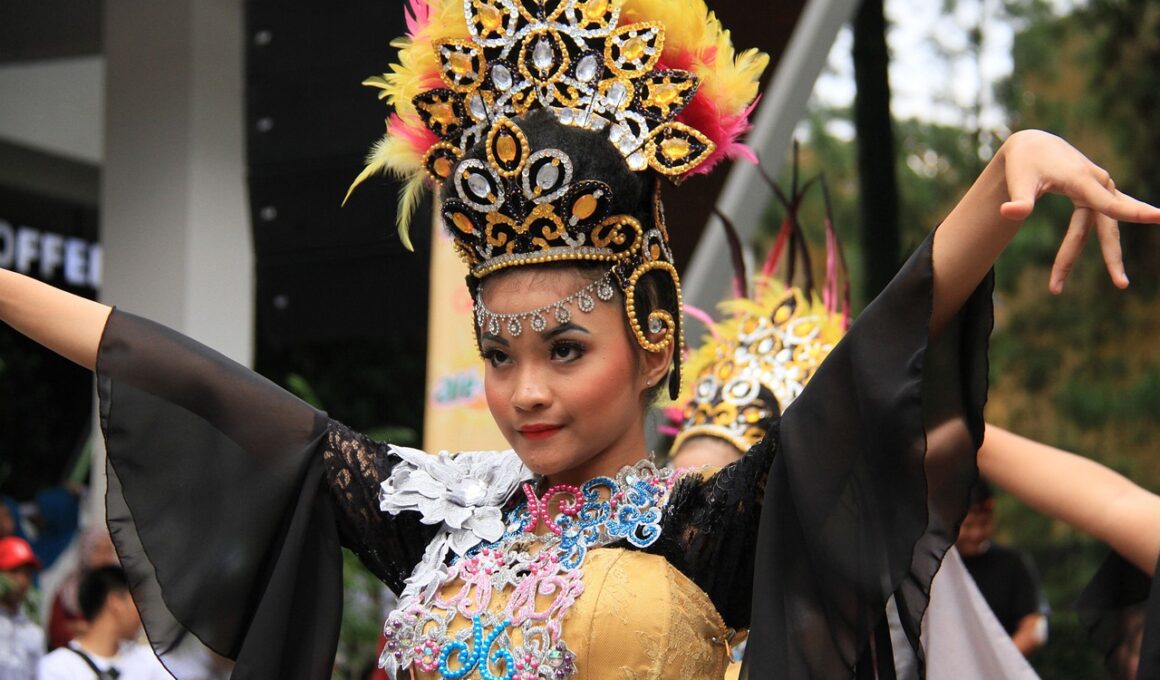Exploring Cultural Dance Therapy Practices for Mental Wellness
Dance therapy is a holistic approach that emphasizes the connection between movement and mental health. Various cultures have particular forms of dance therapy, which are increasingly recognized for their therapeutic benefits. This practice leverages the expressive nature of dance to enhance emotional, cognitive, and social integration. Through rhythm and movement, participants experience a release of their emotions and explore their personal narratives. This process encourages self-expression, creativity, and body awareness, which can significantly enhance mental well-being. In diverse cultural contexts, dances are often utilized not just as art forms but also as rituals to promote psychological healing. For instance, in certain Indigenous cultures, dancing plays a central role in community healing practices. The communal aspects of these practices provide support and belonging, essential for individuals facing mental health challenges. Furthermore, these cultural practices can alleviate symptoms of various mental disorders by promoting joy, connection, and mindfulness. By integrating traditional dance forms into therapeutic practices, mental health professionals can offer a rich, varied approach to treatment, addressing the unique emotional needs of diverse populations.
Furthermore, dance therapy can be tailored to suit different therapeutic needs and preferences. Many clinicians utilize dance as a medium for non-verbal communication, allowing individuals who struggle to articulate their thoughts and feelings to express themselves authentically. Through movement, participants can explore complex emotions while minimizing the anxiety often associated with verbal dialogue. The therapeutic setting encourages freedom and spontaneity, resulting in a dance experience uniquely reflective of each individual. Group therapies often emphasize collaborative movement, facilitating social interactions that can lead to improved interpersonal relationships. Dance therapy has shown particular promise in addressing trauma recovery, as motion may help individuals process their experiences effectively. When trauma is expressed through movement, individuals may gain new insights and pathways toward healing. For instance, therapeutic modalities incorporating traditional dance forms from various cultures can promote emotional release and empowerment while fostering cultural pride. Moreover, studies indicate that rhythmic movement can lead to the release of serotonin and endorphins, further improving mental health. Thus, the fusion of traditional dance practices and modern psychological understanding offers a comprehensive approach to mental health care.
Benefits of Cultural Dance Practices in Therapy
The benefits of integrating cultural dance practices in therapy are extensive and impactful for individuals struggling with mental disorders. One prominent advantage is the promotion of cultural identity, as traditional dance forms frequently represent a community’s history, values, and emotions. Participating in dance provides a sense of belonging, which can be a powerful tool in combating feelings of isolation and depression. This connection to cultural heritage not only encourages participants to embrace their identities but may also foster community ties, helping individuals feel rooted and valued. Additionally, cultural dance practices can diversify therapeutic techniques, accommodating varied clients’ preferences and experiences. This energetic expression can spark joy and vitality, contrasting with the often somber atmosphere of conventional talk therapies. Studies have also revealed that engaging in dance can lead to various health benefits, including reduced anxiety and stress levels. Facilitating the release of pent-up emotions enables participants to navigate their mental health issues more effectively. Engaging with cultural dance therapy thus allows for a seamless blend of personal expression and therapeutic advancement, ensuring an enriching experience that aligns with individual needs and backgrounds.
Incorporating elements from various cultural dance practices into therapy settings acknowledges the importance of diversity in healing approaches. Each cultural dance form has its unique styles and methods, presenting opportunities for individuals to tap into different emotional responses. For example, Afro-Caribbean and Indigenous dances often accompany drumming, rhythms, or chants, creating an immersive experience and enhancing emotional catharsis. Conversely, more meditative forms like Tai Chi can provide tranquility and introspection, addressing anxiety or obsessive thoughts. Emphasizing diversity ensures that therapy is not a one-size-fits-all solution and respects each person’s unique cultural background. Furthermore, incorporating diverse practices can foster a sense of curiosity and openness, inviting individuals to explore new dimensions of themselves. It also facilitates cross-cultural understanding among participants, promoting empathy and connections. In essence, the range of cultural dance practices provides therapists a versatile toolkit, enabling them to engage clients more holistically. By allowing individuals to explore various dance forms, therapy extends beyond traditional boundaries, paving the way for new possibilities in mental health recovery. Thus, this culturally responsive approach can empower clients and enhance their therapeutic journeys.
The Role of Movement in Mental Health
Movement significantly impacts mental health by influencing mood, cognitive function, and overall psychological well-being. Dance therapy effectively highlights how physical activity can augment therapeutic outcomes, addressing both emotional and physical needs. Engaging in rhythmical movement releases endorphins, which can foster happier emotional states and alleviate feelings of anxiety or depression. Additionally, movement serves as an outlet for self-expression, enabling individuals to communicate feelings that might be difficult to articulate verbally. Dance offers a safe space for exploring and confronting distressing emotions while promoting body awareness and acceptance. This awareness nurtures a positive self-image, vital for mental health recovery. Engaging in dance with others can strengthen social bonds, offering support from peers who share similar challenges. Dance therapy can also be particularly beneficial for those recovering from trauma, allowing for safe expression and gradual re-connection with their bodies. By integrating movement into mental health treatment, therapists provide clients with tangible tools for self-regulation and emotional management. Overall, the role of movement through dance emphasizes the profound connection between physical activity and mental health, paving the way for holistic recovery.
Incorporating technology into dance therapy is an emerging trend promoting accessibility and innovation. Dance is now being explored through various digital platforms, expanding reach and enabling collaboration across distances. Online classes and virtual workshops have democratized access to therapeutic dance resources, especially for people in remote or underserved areas. Technology also facilitates personalized dance journeys, allowing clients to explore different styles without geographical or social barriers. Wearable technology can track physiological responses during dance, enabling therapists to tailor interventions based on real-time data. For example, heart rate monitors can provide insights into stress levels, informing the dance movements chosen during sessions. These advancements empower practitioners to create tailored interventions, maximizing therapeutic efficacy. Furthermore, social media platforms have fostered communities around dance therapy, encouraging shared experiences and collective healing. Participants can find inspiration from each other and share their journeys, which can be immensely comforting when dealing with mental health issues. By fusing technology with cultural dance practices, therapeutic opportunities expand significantly, enabling innovative approaches to address mental health needs and revolutionizing traditional methods.
Conclusion and Future Directions
In conclusion, cultural dance therapy practices represent a rich and varied approach to enhancing mental wellness. With a deep-rooted history in many communities, dance not only serves as an art form but as a pivotal part of healing practices. The unique benefits afforded by cultural dance therapy can resonate beyond the individual, positively impacting communities and promoting cultural pride. As mental health professionals continue to embrace creative, integrative approaches, dance therapy stands out as a versatile tool in their arsenal. Encouraging self-exploration, emotional expression, and social connection enables individuals to confront their challenges in a supportive context. By advocating for the inclusion of cultural dance forms in therapeutic settings, we can maintain a commitment to diversity and inclusion that acknowledges all individuals’ unique narratives. Future directions include further research on the efficacy of culturally adapted dance therapies, focusing on specific populations and mental health issues. Expanding access to dance therapy through innovative practices, especially through technology, will significantly enhance therapeutic outreach. As we continue to explore this intersection between art and healing, dance therapy may become a cornerstone of holistic mental health treatment.
By valuing diverse cultural expressions, practitioners can forge deeper connections and cultivate a richer understanding of the healing journey. Ultimately, integration of cultural dance practices offers a promising avenue for transforming mental health care, fostering resilience and empowerment in individuals and communities alike.


